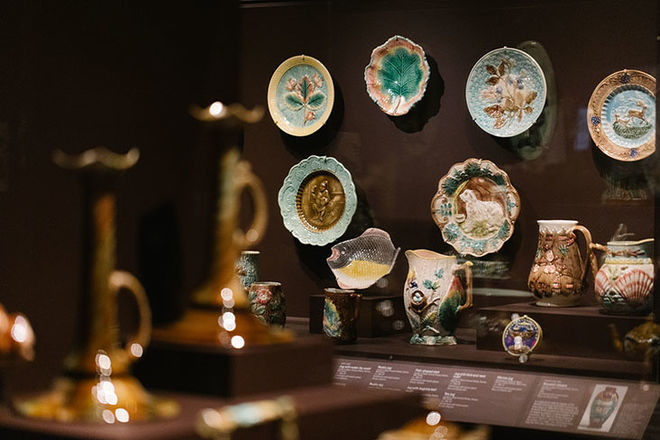
Photo by Da Ping Luo.
The Majolica Mania exhibition and its accompanying three-volume catalogue, both subtitled Transatlantic Pottery in England and the United States, 1850–1915, have won acclaim since they debuted at Bard Graduate Center in fall 2022. Now many of the objects in the exhibition are set to come full circle, returning to Stoke-on-Trent in Staffordshire, England, where they were created. The exhibition will be on view October 8, 2022–January 29, 2023 at the Potteries Museum and Art Gallery in Stoke-on-Trent.
The city has been called “the world capital of ceramics,” and it is commonly known as “the Potteries” after its main industry. A Stoke-on-Trent manufacturer, Minton & Co., introduced majolica to the world at the Great Exhibition of 1851, where the highly modeled earthenware painted with vividly colored lead glazes was viewed as a British triumph of art applied to industry.
According to Susan Weber, founder and director of Bard Graduate Center and the exhibition’s curator, majolica “went on to become a commercial sensation among the middle classes in both Britain and the United States in the decades that followed. … The ware appealed to a cross section of classes and budgets, and by the end of the nineteenth century, could be found in all types of homes.”
Although Minton retained a near monopoly on the majolica trade during the decade following its debut, other manufacturers soon established themselves in the area, including Wedgwood, Wardle, George Jones, T. C. Brown-Westhead Moore & Co, and many others. Weber continued, “agents and wholesalers from all over the world descended on the Staffordshire potting district with order books, searching for the latest designs and novelties available in a range of prices.” The industry benefitted enormously from vital deposits of clays and coal spread throughout the Staffordshire area, which artist and designer Marc-Louis Solon (1835–1913) remarked “could be had by merely scratching the soil.”
Majolica eventually fell from fashion in the late nineteenth century as tastes changed and manufacturers, consumers, and labor reformers realized the hazards of working with lead glazes. However, in 1982, American art critic Rita Reif reviewed the first US museum exhibition of British majolica at the Cooper-Hewitt Museum in New York and commented on the “exuberance and technical virtuosity that are hallmarks of a period which has been thought of, wrongly, as stodgy and lacking in imagination.”
Four decades later, Majolica Mania realizes Reif’s hope of a “comprehensive majolica show,” and the city that gave birth to this bold, innovative, and gloriously colorful pottery awaits the return home of some of its prized creations. The exhibition features more than 150 objects, including a number of iconic works by Minton & Co. from the Potteries Museum’s collection and many from private American collections that have never before been on display in the UK.












